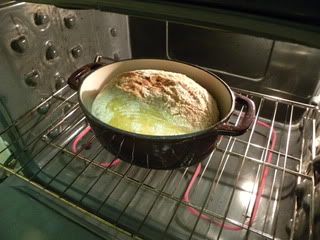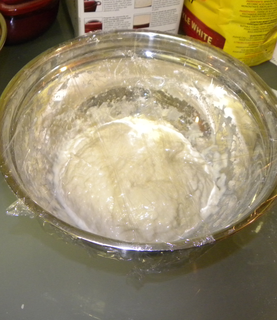There are only FOUR THINGS you need to make a great loaf of bread.
Salt
Water
Yeast
Flour
That's it!
I get my bread recipes from Jim Lahey's book my bread. It's a great book, his No-Knead method is so easy, and the bread tastes great. There's something very satisfying in successfully baking bread and it makes your house smell great. In order to avoid copyright infringement, I will not be posting the full recipe here, but you can find it here on another blog, The Wednesday Chef.
Aside from the four ingredients, there are other supplies you will need.

A dutch oven is the most important (the red pot with lid pictured above). It's your oven in an oven and will bake your bread to perfection.
Mixing your ingredients according to the book's instructions, you leave it to rise for at least 12 hours, preferably 18 or 20 at room temperature, away from drafty areas.
After letting your dough rise, you shape it roughly into the shape of a ball and, seam down on a cotton cloth, allow it to rise further for two hours.
Preheat your oven at 450 degrees about a half hour before your dough will be ready. Put your dutch oven in your oven as it heats. When your dough is ready, slide your hand under the cloth and flip it seam side up into your warm (hot! Don't burn yourself!) ceramic pot. Bake for 30 minutes with the lid on, and 20 - 30 with the lid off.

Once your loaf is ready to come out, cool on a rack. As it cools, you'll be able to hear it sing! This was the coolest part for me. Lahey describes it as the last phase of cooking. I know you're tempted to start slicing the bugger right away, but you have to let your bread cool on the rack for at least an hour. As it cools, the crust shrinks and cracks, and steam from the inside - what is known as the crumb - escapes through the cracks. This solidifies the crumb as the moisture escapes and makes the crackling noises known as singing.
Preheat your oven at 450 degrees about a half hour before your dough will be ready. Put your dutch oven in your oven as it heats. When your dough is ready, slide your hand under the cloth and flip it seam side up into your warm (hot! Don't burn yourself!) ceramic pot. Bake for 30 minutes with the lid on, and 20 - 30 with the lid off.

Once your loaf is ready to come out, cool on a rack. As it cools, you'll be able to hear it sing! This was the coolest part for me. Lahey describes it as the last phase of cooking. I know you're tempted to start slicing the bugger right away, but you have to let your bread cool on the rack for at least an hour. As it cools, the crust shrinks and cracks, and steam from the inside - what is known as the crumb - escapes through the cracks. This solidifies the crumb as the moisture escapes and makes the crackling noises known as singing.



No comments:
Post a Comment